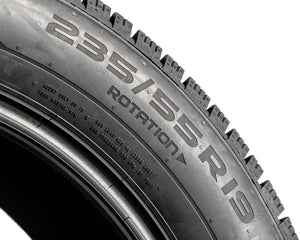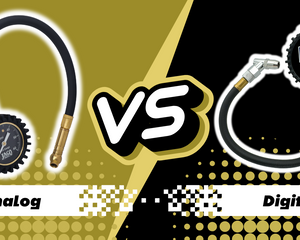Proper tire pressure is an important aspect of maintaining your ATV or UTV. Underinflated tires can lead to a range of problems, including reduced handling and stability, increased wear and tear on the tires, and decreased fuel efficiency. On the other hand, overinflated tires can also be problematic, causing a rough ride and increased risk of damage from impacts. In this article, we'll discuss the importance of maintaining proper tire pressure for your ATV or UTV and how to do it correctly.

Why ATV Tire Pressure Matters
First and foremost, properly inflated tires are essential for the safe and effective operation of your ATV or UTV. Underinflated tires can cause a number of problems, including reduced handling and stability. This can make it difficult to control the vehicle, especially at high speeds or when navigating rough terrain. Underinflated tires can also increase the risk of accidents or rollovers, putting you and your passengers in danger.
In addition to safety concerns, underinflated tires can also cause increased wear and tear on the tires themselves. When a tire is underinflated, it flexes more as it rotates, generating more heat and wearing out the tire more quickly. This can lead to premature tire failure.
In addition to the safety and longevity concerns, maintaining proper tire pressure can also help improve the fuel efficiency of your ATV or UTV. Underinflated tires create more resistance as they roll, which can cause the engine to work harder and use more fuel. By keeping your tires properly inflated, you can help your vehicle operate more efficiently and save money on fuel in the long run.
Tires and the Terrain
On the trail, tires have a big impact on how your ATV or UTV handles. The right tire pressures can make the difference between a smooth ride and one that's jarring and uncomfortable. Likewise, different pressure settings are required for different terrains. If you're riding over hard-packed dirt trails, your pressure will be much lower than if you're slogging through mud in thick off-road tires. And it's important to note that these numbers aren't set in stone; every rider has an individual preference when it comes to how soft or firm their suspension should feel when going over bumps and dips in the terrain—when it comes down to it, there's no wrong way to set up your suspension!
But just as important as proper inflation levels are the tread pattern of your tires and what type of terrain they're designed for—a set of slick street tires won't hold up well on an ATV trail carved out from thick woods. Know what kind of terrain you plan on riding through before picking out new rubber for your machine!

ATV Tire Pressure Maintenance
So, how do you know what the proper tire pressure is for your ATV or UTV? The best place to start is by checking the owner's manual for your vehicle. It should include the recommended tire pressure for your specific make and model. If you can't find the information in the manual, you can also check the sidewall of the tire itself. Most tires will have the maximum pressure rating listed on the sidewall, along with the recommended pressure for the specific load and speed rating of the tire.
Once you know the proper pressure, you can use a tire pressure gauge to check the current pressure of your tires. It's important to check the pressure when the tires are cold, as driving the vehicle can cause the tires to heat up and give a false reading. If you notice that the pressure is low, you can use a portable air compressor or a manual air pump to add air to the tires. Be sure to check the pressure again after adding air to make sure you have reached the proper level.
Choose the right tire gauge for your ATV or UTV

When choosing a tire gauge for use with low pressure ATV and UTV tires, there are a few key factors to consider. First and foremost, you'll want to make sure the gauge is capable of accurately measuring low pressure levels. Many tire gauges are designed for use with passenger vehicle tires, which typically have higher pressure levels. For ATV and UTV tires, which often require lower pressure levels, you'll need a gauge that is specifically designed for measuring low pressure. We highly recommend the JACO Elite Tire Pressure Gauge - 30 PSI for use with ATV and UTV tires.
Another option is to choose a digital tire gauge, which can often provide more precise readings than a traditional analog gauge. Digital gauges typically have a wide range of measurement, allowing you to accurately measure low pressure levels as well as higher pressure levels. They also often include features like automatic shut-off and a backlit display, which can make it easier to use the gauge in low light conditions.
In addition to these factors, it's also a good idea to look for a tire gauge that is durable and easy to use. A gauge with a sturdy construction and a comfortable grip can make it easier to use the gauge accurately and consistently. Look for a gauge with a long hose or flexible nozzle, which can make it easier to reach the valve stem on your ATV or UTV tires. Overall, by considering these factors and choosing a tire gauge that is specifically designed for low pressure ATV and UTV tires, you can help ensure that you are able to accurately and easily measure the pressure of your tires.
Safety Tips for a Fun Ride
-
Before you even get on the ATV or UTV, check the tire pressure. If it's too low, don't risk driving off with a flat tire—it could cause you to crash and hurt yourself or others.
-
After every ride, check your tires again. You never know what your tires have hit while you've been away! It might be just fine to drive through a puddle or two, but if there were rocks in that puddle that your tires rolled over? That's when you need some air added!
-
If you've been driving through water and mud, give those tires some serious attention with an air compressor. They might have picked up debris from underneath them (like sticks) that could puncture the side walls of the tire when rolling over them at high speeds on pavement again--and we all know how dangerous flat tires can be when traveling at high speeds!
Final Thoughts
In conclusion, maintaining proper tire pressure is crucial for the safe and efficient operation of your ATV or UTV. Underinflated tires can cause reduced handling and stability, increased wear and tear, and decreased fuel efficiency. By checking the pressure regularly and maintaining the recommended level, you can help ensure that your vehicle performs at its best and keeps you and your passengers safe on the trails.




